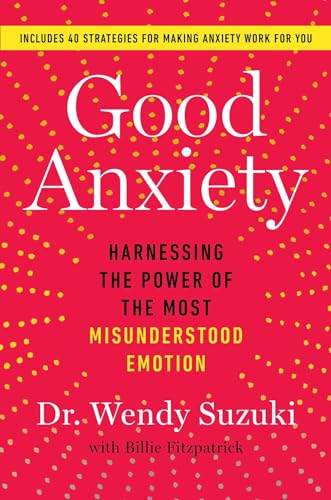Good Anxiety: Harnessing the Power of the Most Misunderstood Emotion

“a book that is erudite, practical, reader-friendly, deeply personal, and sure to help even the most anxious among us.”
Good Anxiety is a welcome addition to the self-help genre for garden-variety worriers, casualties of stress, and people who have been diagnosed with Generalized or Social Anxiety Disorder, Post-traumatic Stress Disorder, Panic Attacks, or Social Phobias. It is also instructive for therapists who seek a fresh, science-based approach to help clients stop struggling against anxiety and use it, instead, as a way to improve their lives.
Dr. Wendy Suzuki, a TED-talk headliner and Professor of Neural Science and Psychology in the Center for Neural Science at New York University, reframes anxiety as a force for good, viewing it not as a negative emotion to run from or get rid of, but as a “superpower” that teaches us what we need to know and do to live our best lives. She has written a book that is erudite, practical, reader-friendly, deeply personal, and sure to help even the most anxious among us.
Part One describes anxiety as our automatic threat detector, a chemical reaction hard-wired in humans. It causes “an arousal and activation of both brain and body when it encounters negative stimuli or stress” and “like a form of energy, the arousal of anxiety takes on a positive or negative cast depending on how an individual responds to a particular stressor, or outside force.” Perceiving a threat, the brain defaults to survival mode, stores memories involving pain so that they are easily accessible, and encodes them more deeply than other memories.
Anxiety’s downside is that it is poor at discerning nuances of threats, and therein lies the problem: In this day and age, compared to hundreds of thousands of years ago, we encounter less real danger and, therefore, our brain registers more false positives than is useful. To our detriment, our brains have not evolved sufficiently to respond appropriately to today’s complex landscape in an appropriate manner.
Fortunately, due to the brain’s ability to change, known as neuroplasticity, we can learn to alter our thinking and more effectively regulate our emotions. This is a key point in the book because most people, especially those who lean toward high anxiety, do not realize that they can control their thoughts and feelings with the right tools and practice. Dr. Suzuki explains why and how we can do this by shifting attention, modulating our response to emotion, cognitive reframing, and situation selection and modification.
Part One of the book also describes the ways we use anxiety as a motivator for better or worse; how negative physiological responses to anxiety “represent a downregulation in functioning of various neural pathways of the brain and body”; the difference between adaptive and maladaptive coping mechanisms; and why anxiety and depression so often co-exist within us.
Part Two explains the mental and physical stages of the stress response, ways that chronic anxiety can weaken effective coping, how to worry well by learning to supercharge resilience and grow from hardship and pain, and the distinctions among positive, tolerable, and toxic stress responses. Dr. Suzuki shows us how an optimistic outlook, cognitive flexibility and reappraisal, social support, humor, physical exercise, altruism, and mindfulness are major factors in building resilience. This section also includes Dr. Suzuki’s own painful story of how she learned to cope with the sudden death of her beloved brother.
The author explains how the concept of flow can combat anxiety. It is defined as a “deeply engaging state where high skill/performance accompanies a seemingly relaxed, almost effortless state of mind, one of intense enjoyment and immersion.” Flow happens when the right combination of cognitive, physical, and emotional features almost magically align so that we reach “an optimal level of arousal and its resulting anxiety that maximizes performance”—we’re so engaged in doing something that we’re not thinking about doing it, it’s simply happening.
In order to learn to “worry well,” we need an activist mindset that is intentional, proactive, and focused on success. This outlook comes from attending to achievements rather than failures and accentuating the positive, not the negative. It requires a “growth” versus a “fixed” mindset and assumes that we can (and must) manage our thinking through positive self-talk. Dr. Suzuki also encourages anxious people to improve their social intelligence and gain support by increasing empathy and compassion and to boost creativity to access the state of flow.
Part Three consists of worksheets and questionnaires on anxiety and emotional regulation, self-soothing activities that include attention diversion, meditation, deep breathing, sleeping and eating well, and calming exercises. Dr. Suzuki stresses that the key to success is practicing new ways of thinking, feeling, and acting. Flipping pessimism to optimism, challenging yourself, spending time in nature, and reaching out to people are among the numerous strategies she puts forth to reduce anxiety.
What makes this book stand out among others written about anxiety is its premise of putting it to work for you, readable writing style, practical advice, scope of scientific research, easy-to-identify-with case studies, and infusion of the author’s fervent belief, from her expertise in neuroplasticity and her own experiences with anxiety, that we can, indeed, learn to worry better.